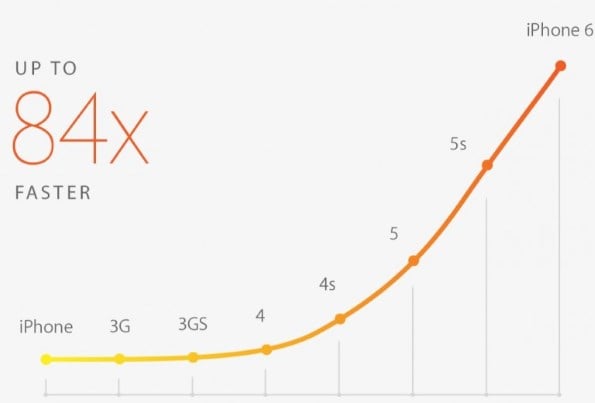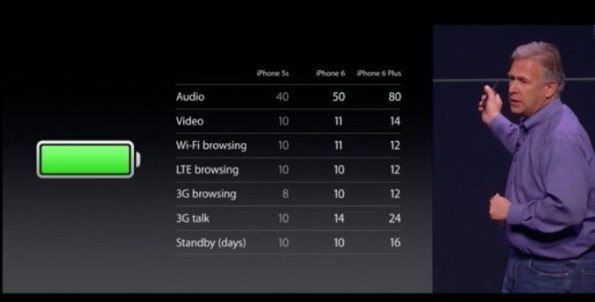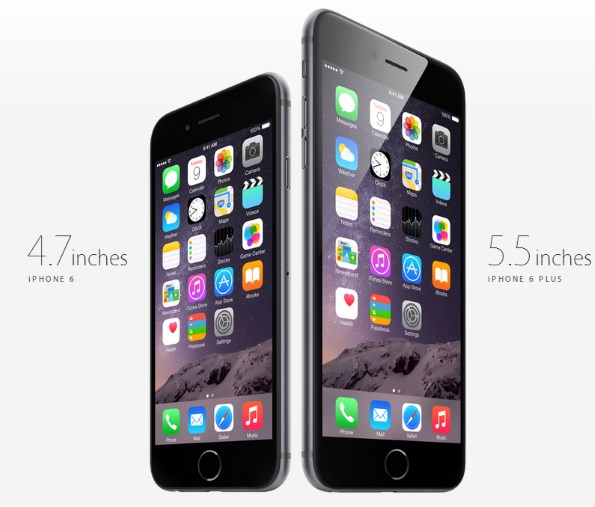Today, Apple unveiled the upcoming iPhone 6 and 6 Plus, ending months of speculation over whether or not the company would ever move to larger screens or higher PPI. The answer, it turns out, is yes -- the iPhone 6 will pack a 4.7-inch screen while the iPhone 6 Plus has a 5.5-inch screen. Resolution on the iPhone 6 is 1134x750 (326 PPI) while the iPhone 6 Plus hits 1920x1080 and 401 PPI.
These figures aren't as high as some Android phones, but we've already hit the point of diminishing marginal returns since the original iPhone 4 launched the concept of a Retina Display. Unless you have better than 20/20 vision, a display is always Retina at a certain distance -- and the iPhone 6 and 6 Plus will continue to qualify even at larger screen sizes.
Doubled Transistor Counts
When Apple unveiled the A7 SoC, it noted that the dual-core chip was a 1B transistor part with some of the best per-core performance of any ARM SoC currently on the market. Now the company has doubled the transistor count with its new A8, packing a whopping two billion transistors into a mobile part. That's some serious silicon -- even Intel's quad-core Haswell server chips are only about 2.6B transistors.

What's Apple doing with all that silicon? It's not clear. We know that graphics performance increases sharply between the iPhone 5S and 6, so this implies that the company has pushed the graphics engine even harder, but it's also possible that the A8 is a quad or triple-core design.
Apple is claiming 50% higher performance over the A7 overall, but the GPU is expected to increase more sharply than the CPU. Battery life is also projected to increase -- but if you want the best overall battery life, you'll want to investigate the larger 5.5-inch iPhone 6 Plus.

The iPhone 6 improves on the iPhone 5S in several battery metrics, but Apple is clearly packing a much larger battery into the 6 Plus -- 3G talk time nearly doubles, as does audio playback and standby time. Interestingly, the increase in Video playback and WiFi browsing is much more modest. It's not clear why.

What's really interesting about the A8 SoC is that it seems to buck the trend on what people were expecting from 20nm in general. For months, TSMC has warned that 20nm should be considered a stair step, not a major node transition. Apple's new foundry partner doesn't expect to introduce FinFET technology until next year's 16nm node, which means the gains from using 20nm planar were supposed to be in the 15-20% range for both power consumption and die size.
Instead, Apple is reporting that the A8 die is now 15% smaller than A7, despite more than doubling transistor counts. Since there's no reason to believe that TSMC has lied about its expectations for the node, the implication is that Apple found a way to substantially rearchitect the die in more efficient fashion.
We'll know more once a company like Chipworks gets their hands on a teardown of the die. Apple is reportedly already planning to ramp production of a 14nm chip with Samsung, so this TSMC pivot could be a flash in the pan -- or, if the chip really hit dramatic milestones, the company might plan to use both fabs for different projects.
These figures aren't as high as some Android phones, but we've already hit the point of diminishing marginal returns since the original iPhone 4 launched the concept of a Retina Display. Unless you have better than 20/20 vision, a display is always Retina at a certain distance -- and the iPhone 6 and 6 Plus will continue to qualify even at larger screen sizes.
Doubled Transistor Counts
When Apple unveiled the A7 SoC, it noted that the dual-core chip was a 1B transistor part with some of the best per-core performance of any ARM SoC currently on the market. Now the company has doubled the transistor count with its new A8, packing a whopping two billion transistors into a mobile part. That's some serious silicon -- even Intel's quad-core Haswell server chips are only about 2.6B transistors.

What's Apple doing with all that silicon? It's not clear. We know that graphics performance increases sharply between the iPhone 5S and 6, so this implies that the company has pushed the graphics engine even harder, but it's also possible that the A8 is a quad or triple-core design.
Apple is claiming 50% higher performance over the A7 overall, but the GPU is expected to increase more sharply than the CPU. Battery life is also projected to increase -- but if you want the best overall battery life, you'll want to investigate the larger 5.5-inch iPhone 6 Plus.

The iPhone 6 improves on the iPhone 5S in several battery metrics, but Apple is clearly packing a much larger battery into the 6 Plus -- 3G talk time nearly doubles, as does audio playback and standby time. Interestingly, the increase in Video playback and WiFi browsing is much more modest. It's not clear why.

What's really interesting about the A8 SoC is that it seems to buck the trend on what people were expecting from 20nm in general. For months, TSMC has warned that 20nm should be considered a stair step, not a major node transition. Apple's new foundry partner doesn't expect to introduce FinFET technology until next year's 16nm node, which means the gains from using 20nm planar were supposed to be in the 15-20% range for both power consumption and die size.
Instead, Apple is reporting that the A8 die is now 15% smaller than A7, despite more than doubling transistor counts. Since there's no reason to believe that TSMC has lied about its expectations for the node, the implication is that Apple found a way to substantially rearchitect the die in more efficient fashion.
We'll know more once a company like Chipworks gets their hands on a teardown of the die. Apple is reportedly already planning to ramp production of a 14nm chip with Samsung, so this TSMC pivot could be a flash in the pan -- or, if the chip really hit dramatic milestones, the company might plan to use both fabs for different projects.
No comments:
Post a Comment